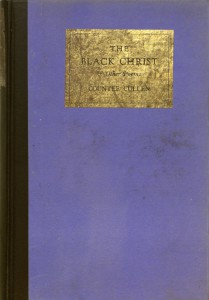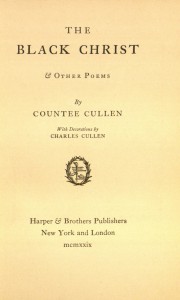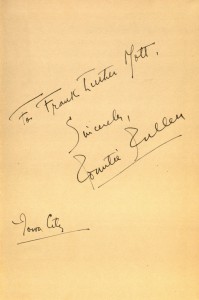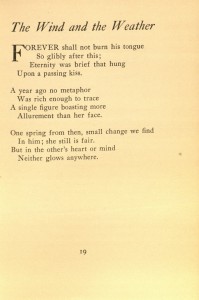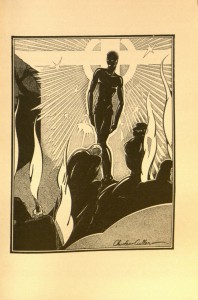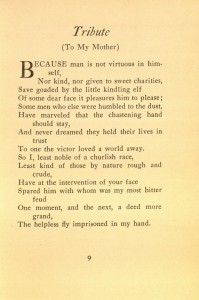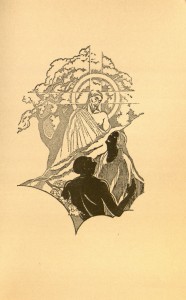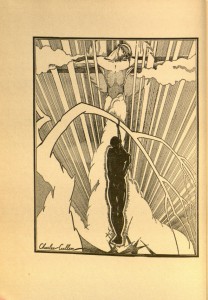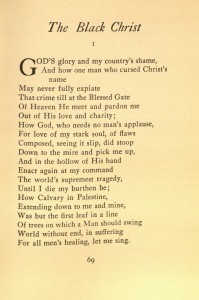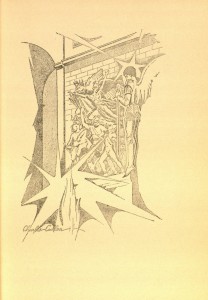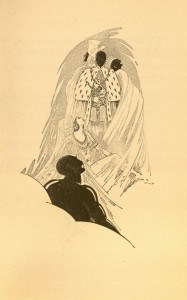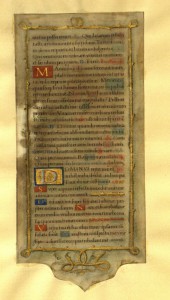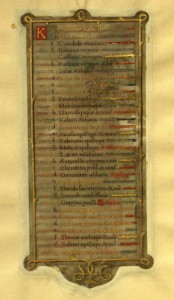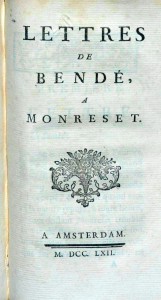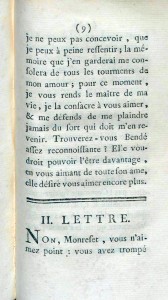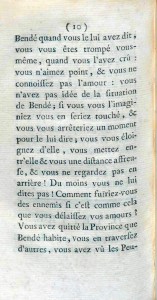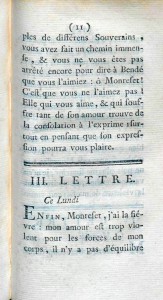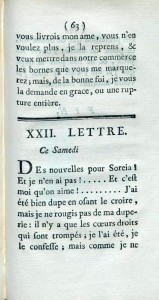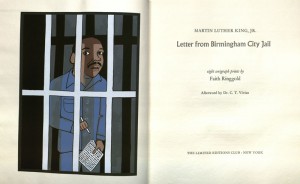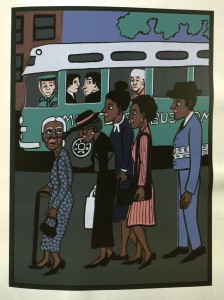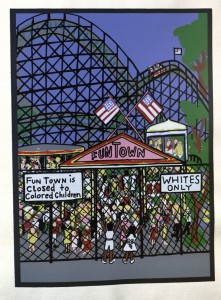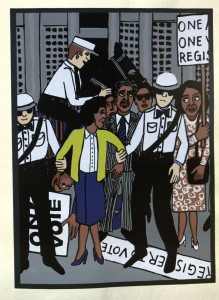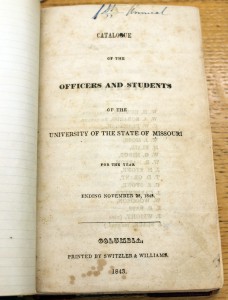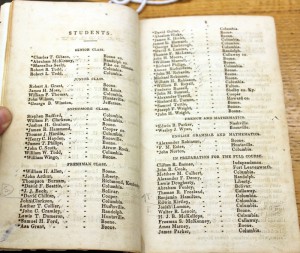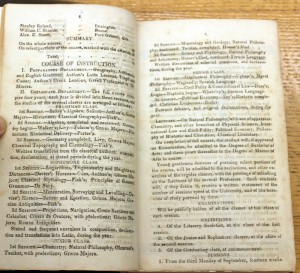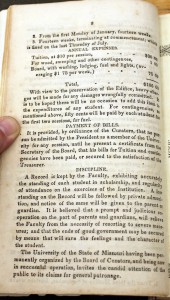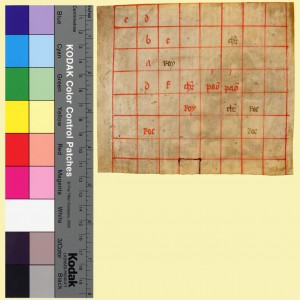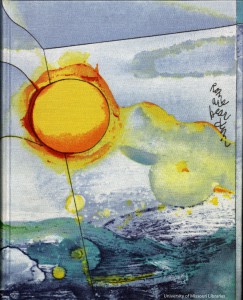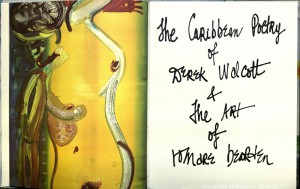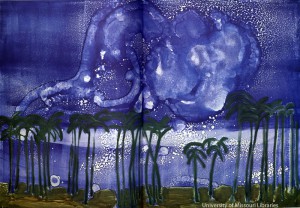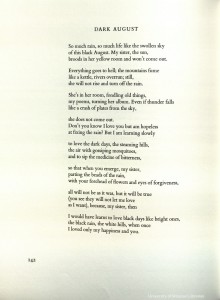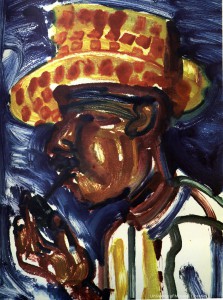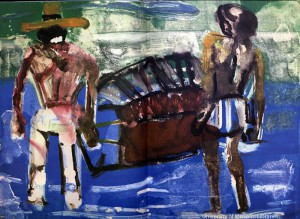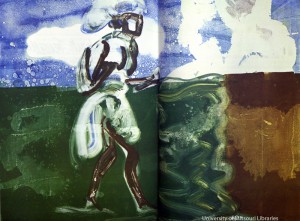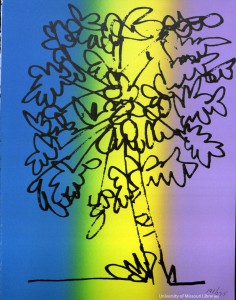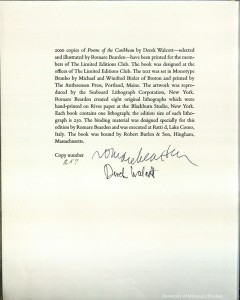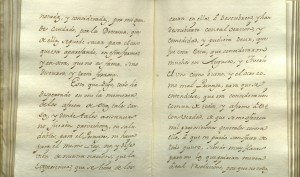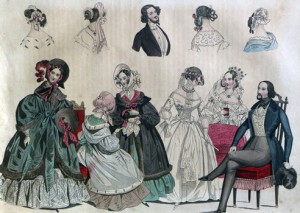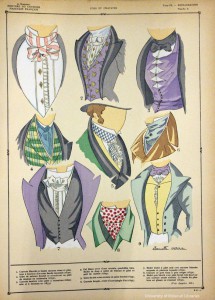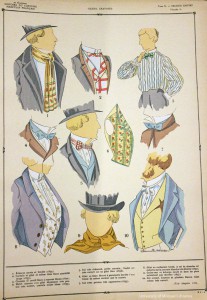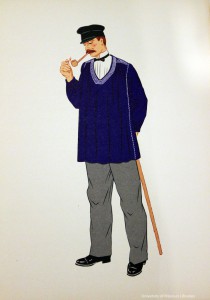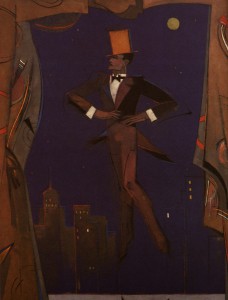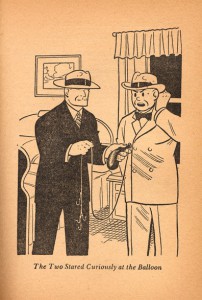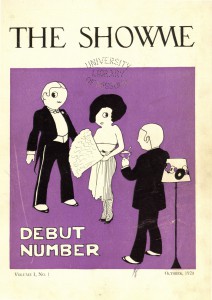This post is the third in our series highlighting the work of African-American artists and authors in Special Collections. Countee Cullen was one of the leading poets and intellectuals of the Harlem Renaissance. This book of poetry, published at the height of his career, examines the relationships between faith and injustice. Cullen draws parallels between the suffering of the crucified Christ and the suffering of African Americans in the climate of racial violence that characterized the 1920s. The copy in Special Collections is inscribed by Cullen to Frank Luther Mott, who was Dean of the School of Journalism from 1942 to 1951.
Kelli Hansen
Fragments from a Book of Hours
No librarian is happy to see a broken book, but we're lucky to have eight leaves from this sixteenth-century book of hours. Two of the leaves in Special Collections were originally part of John Bagford's Fragmenta Manuscripta collection – meaning they were removed from the book by the late seventeenth century. Bagford's fragment collection passed to St. Martin-in-the-Fields in the eighteenth century. The collection was sold in 1861 to Sir Thomas Phillipps, then to Sir Sydney Cockerell in 1913. In 1957, the collection was bought by the bookseller William Salloch, and it came to the University of Missouri in 1968.
The remaining parts of the manuscript (it's not clear how much) were eventually broken around 1920. In the 1980s, Margaret Howell, then director of Special Collections, noticed a set of six leaves on the market, and she was able to reunite at least a portion of this beautiful book of hours.
All eight of the leaves are cropped in the same manner and show signs of damage from flooding in London in 1846. The manuscript was produced in the style of Geoffroy Tory, an influential type designer of the Renaissance. This humanistic script may look printed, but it's all written by hand. See more in the Digital Scriptorium: Fragmenta Manuscripta #212, #213, and the six additional pages.
For a great recent overview of the topic of book breaking and its implications for libraries, see This Just In: Breaking Bad by David Whitesell at the Albert and Shirley Small Special Collections Library, University of Virginia.
The worst love letters no one’s ever read
In honor of Valentine's Day, we're posting a few pages from a one-sided collection of love letters that make up a French epistolary novel called Lettres de Bendé, a Monreset. The novel has an imprint of Amsterdam (fictitious?), and is dated 1762. A researcher in France recently emailed us with a question about this book, and in the course of our investigations we found that we have the only recorded copy, according to WorldCat.
It's always exciting to find a unique copy, but there may be a good reason for this title's near extinction. This isn't a happy love story. Friedrich Melchior, baron von Grimm, explains in a review published in his Correspondance litteraire:
Ce sont les lettres d'une femme qui aime et qui n'est point aimée. Ajoutez qu'elle ne mérite pas de l'être, car elle est insipide, guindée, sans naturel, sans grâce. Si ces lettres n'étaient pas si mauvaises, on serait tenté de croire qu'elles ont été confiées à l impression par une femme qui n'avait que cette voie pour apprendre à son amant sa situation et ses sentiments.
These are letters written by a woman who loves but is not loved. What's more, she does not deserve to be loved because she is dull, affected, stiff, and ungraceful. If these letters were not so bad, one would be tempted to believe that they have been entrusted to printing by a woman who had no other way of apprising her lover of her situation and feelings.
Ouch. Are they really that bad? You be the judge. Brush up on your French, and take a look at the few, perhaps not-so-tantalizing pages we offer below; the rest will be freely available in our digital library soon.
King’s Letter from Birmingham City Jail with Prints by Faith Ringgold
This week we're highlighting Faith Ringgold's illustrations for Letter from Birmingham City Jail by Martin Luther King, Jr. Produced in 2007 for the Limited Editions Club, the book contains eight original serigraphs by Ringgold alongside a beautifully printed text by King. Special Collections has copies 119 and 132 from an edition of 400.
Happy 175th Birthday, Mizzou!
Today is the 175th anniversary of the founding of the University of Missouri on February 11, 1839. We're joining in on the celebrations by sharing the very first University of Missouri catalog, one of the oldest items in the University of Missouri Collection. It wasn't issued until 1843 – that's the first year the university had a senior class – but it's an important piece of our history and shows just how far we've come over these 175 years.
As you can see below, the first senior class was made up of five students – two of whom were named Robert Todd. If you've been around Columbia for a year or two, you may recognize some of the other last names on buildings and street signs around town.
There were no majors back then. Everyone took the same course of study, which was divided into three sessions per year.
"The University of Missouri having been permanently organized by the Board of Curators, and being now in successful operation, invites the candid attention of the public to its claims for general patronage."
For more on the history of the university, check out the digital exhibits available through the University Archives.
Medieval Chess Problem
How about a little brainteaser with your Monday manuscript? This is a chess problem from a fourteenth-century manuscript. It's Fragmenta Manuscripta #194. The entire Fragmenta Manuscripta collection is online at the Digital Scriptorium.
The Caribbean Poetry of Derek Walcott and the Art of Romare Bearden
In honor of Black History Month, we're highlighting the work of African-American artists and authors in Special Collections. Artist Romare Bearden and poet Derek Walcott participated in this beautiful collaboration for the Limited Editions Club in 1983. We've selected a few of our favorite images to share here, including the gorgeous decorated cloth binding, which is the first image below.
Carta de el secretario
For this week's manuscript, we're posting a couple of pages from Carta de el secretaro, Antonio Perez, al duque de Lerma de la manera que seharia de governar en la privanza.
The manuscript was produced between 1568 and 1579. It's quite a long letter written by Antonio Perez, secretary to Philip II of Spain, addressed to the duke of Lerma, providing advice for princes on governing from privilege, illustrated with examples from the Spanish court. Find it in the MERLIN catalog.
Teaching Spotlight: Ruth Knezevich
 Our popular teaching spotlight series returns this semester with a fresh look at innovative teaching in Special Collections. This month's featured educator is Ruth Knezevich, an instructor in the English department at Mizzou.
Our popular teaching spotlight series returns this semester with a fresh look at innovative teaching in Special Collections. This month's featured educator is Ruth Knezevich, an instructor in the English department at Mizzou.
SC: Could you tell us a bit about yourself?
I am a doctoral candidate and graduate instructor in the English department. My research focuses largely on in late 18th– and early 19th-century British literature with interests in ballad collections, Scottish Romanticism, and the emergence of “folk” literatures. My dissertation in-progress is on footnotes within ethnographic poetry and novels of this timeframe. When I’m not reading, writing, or teaching, I enjoy spending time outdoors and traveling, especially in and around my native northern Minnesota.
At MU, I’ve taught a handful of literature-based courses, including English 1000H (Honors Exposition), English 1210 (Introduction to British Literature), English 2100 (Writing About Literature), English 2159 (Introduction to World Literature), and English 3200 (Survey of British Literature, Beginnings through 1784).
In each of these courses – in addition to teaching critical thinking and reading skills – I like to show students that there are more ways to read a book than breaking down the words on the page, and that there is more to literature than just reading a book and looking at the arrangement of words on a page – each book holds a story of the world around it and the readers who have picked it up, read it, and written in it.
SC: How have you incorporated Special Collections into your teaching?
Each semester, I ensure that I bring my classes to visit Special Collections and spend time learning about various aspects of printing history, reading a book as more than just literature, and letting students get their hands on the materials. And frankly, Rare Books and Special Collections adds variety to times in the semester where we’re all feeling a little bogged down and need a new and exciting way to approach the text.
One semester, I brought my students in Survey of British Literature to Special Collections as a way to break up the monotony of our class discussion on Renaissance poetry. Alla and Kelli brought out a variety of publications and objects featuring the same poems and authors we were reading in class; students were encouraged to dive into reading the primary materials in their original context, outside of the anthology we were using in class. Suddenly, Ben Jonson and Amelia Lanyer came to life for students as they struggled through the centuries-old typography.
I have also asked my honors composition students to actively read selected from Special Collections as objects, carefully analyzing and writing about their thoughts and findings. Students were asked to choose one of the manuscripts or objects that were displayed during our class’s visit to Rare Books and Special Collections, and to spend time with it again outside of class, asking questions of the object, analyzing it, and drawing inferences from their observations of details they might otherwise overlook and then inferring how the book would have been used and who might have used it.
SC: What materials or collections did your students work with?
The various classes I have brought to Special Collections have worked with a wide array of materials and collections, including 19th-century travel writing, publications of Renaissance-era poetry, 18th-century editions of Homer, different antique versions of the Bible, and 16th-century documents addressing the politics of magic and religion.
SC: What outcomes resulted from your class visits? What were the effects on your students?
In addition to submitting some rich essays from the students detailing their findings from their assignments based on Special Collections, students consistently walk away from their visit in awe, inspired to discover what else is held in Special Collections.
One specific moment that will remain with me is when tears began welling up in one student’s eyes as she held an 800-year-old book. “I’m a part of this book’s history now,” she whispered to a classmate standing next to her. Another student, a college senior, said that the days spent in Rare Books and Special Collections were the highlights of her time in college, and that it was a shame that she was just learning about one of MU’s most exciting resources right as she was about to graduate.
SC: What advice would you give to colleagues interested in using Special Collections in their courses?
When I set aside a day for my class in Special Collections, I often don’t yet know exactly what I want my students to explore. The librarians have consistently helped me figure out the aims and goals of the day’s visit, suggested specific materials, provided samples for follow-up assignments, and offered to lead lectures for the class on topics related to the course.
For instance, I recently taught a unit on Christopher Marlowe’s play, Doctor Faustus, and I had asked the librarians to pull some resources that could be relevant and helpful in exploring the politics of magic and religion expressed in the play. Little did I know that Alla is actually an expert in Renaissance magic! My students were able to get so much more out of the library session than they ever imagined, and more than I could ever offer.
So, the biggest piece of advice that I would give to colleagues interested in using Special Collections in their courses is to use it! The staff in Special Collections is immensely helpful in putting together a productive and exciting day with demonstrations of the materials and offering suggestions for follow-up assignments.
Welcome to Mizzou, Chancellor Loftin!
We're excted to welcome our new Chancellor, R. Bowen Loftin, to Columbia. He's well-known his fashionable bow ties, so in his honor, we're presenting a gallery of neckerchiefs, cravats, ties, and of course, bow ties, in historical illustrations from our collections. More information about each illustration is below.
 Dapper bowtie-wearing gentlemen from Allgemeine Modenzeitung (1823, above; 1839, below)
Dapper bowtie-wearing gentlemen from Allgemeine Modenzeitung (1823, above; 1839, below)
Ties and cravats from the Bourbon Restoration (above) and the Second Empire (below) from Histoire du costume masculin français
Traditional dress of Lozére (above) and Alsace (below) from French Costumes by Lepaige-Medvey (London, 1939)
The great Gatsby himself (Limited Editions Club, 1980)
From the pages of Red Ryder Comics…
…and Dick Tracy!
And finally, the very first cover of Showme, MU's long-running student humor and literary magazine.
